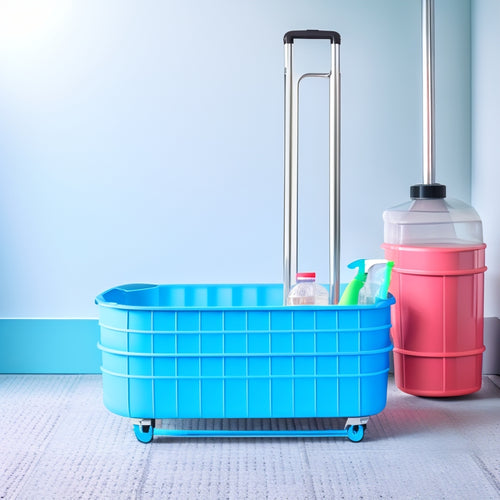
Toilet Guidebook Spurs Safe Post-Disaster Practices
Share
A thorough toilet guidebook is necessary for promoting safe post-disaster practices, particularly in preventing waterborne diseases. Key elements include identifying local resources, distributing educational materials, and adopting bucket hygiene and composting practices. Bucket design and preparation are crucial, with considerations for efficient waste separation, easy cleaning, and cultural sensitivity. Visual aids and community engagement are also essential in disseminating critical information and fostering awareness. Effective messaging strategies can mitigate disease risks and address public health concerns. By understanding these essential components, communities can better prepare for and respond to disasters, and uncover the nuances of safe post-disaster sanitation practices.
Key Takeaways
• A comprehensive toilet guidebook is essential for promoting safe post-disaster toileting practices and preventing waterborne diseases.
• Bucket preparation and design are critical for efficient separation of pee and poo, easy cleaning, and proper waste management.
• Visual aids, such as infographics and posters, are effective in educating communities on safe toileting practices, especially in low-literacy settings.
• Outreach and community engagement are crucial for promoting awareness and preparedness, and disseminating critical information on safe sanitation practices.
• Clear and effective messaging by Emergency Managers and Public Health officials is vital for mitigating waterborne disease risks and promoting safe hygiene practices.
Safe Toileting Essentials
In the aftermath of a disaster, access to safe toileting facilities is essential for preventing the spread of waterborne diseases. A fundamental understanding of safe toileting essentials is necessary for mitigating this risk. Bucket hygiene and composting practices are key in this situation.
Communities can prepare by identifying local resources, such as free buckets, and distributing educational materials on safe toileting practices before and after disasters. This includes information on separating pee and poo, and promoting clean habits without running water.
Bucket Preparation and Design
Effective bucket preparation and design are essential for safe and hygienic post-disaster toileting practices, as they enable efficient separation of pee and poo, facilitate easy cleaning, and promote proper waste management. When sourcing buckets, consider using 5-6 gallon containers that are durable, easy to clean, and have a tight-fitting lid. Design considerations should prioritize ease of use, accessibility, and adaptability to different environments.
| Bucket Sourcing | Design Considerations |
|---|---|
| Free buckets from local businesses | Durable, easy to clean materials |
| Online purchasing options | Tight-fitting lid for odor control |
| Community donations | Adaptability to different environments |
Composting options, such as pellet stoves, can be integrated into bucket design to promote sustainable waste management. By carefully considering bucket sourcing and design, individuals can create effective and hygienic toileting systems that support safe post-disaster practices.
Visual Aids for Education
Visual aids play an essential role in educating communities on safe post-disaster toileting practices. They facilitate understanding and retention of critical information, particularly in low-literacy or multilingual settings.
Infographic resources and educational posters are indispensable tools for disseminating important information on proper toileting practices, waste management, and hygiene. These visual aids can be designed to be culturally sensitive, easy to comprehend, and adaptable to various languages.
Outreach and Community Engagement
Through targeted outreach and community engagement initiatives, emergency responders and public health officials can promote safe post-disaster toileting practices, fostering a culture of awareness and preparedness that mitigates the risk of waterborne diseases.
Community engagement is essential in disseminating critical information on safe toileting practices. Some effective strategies include:
- Organizing community workshops to educate residents on the importance of proper waste disposal
- Distributing outreach materials, such as brochures and posters, in multiple languages to reach a wider audience
- Collaborating with local community leaders to amplify the message and build trust
- Utilizing social media platforms to share engaging content and visuals
- Providing hands-on training on the use of emergency toilet systems, such as the twin bucket system
Effective Post-Disaster Messaging
What role does clear and concise communication play in promoting safe post-disaster sanitation practices, and how can Emergency Managers and Public Health officials leverage messaging to mitigate the risk of waterborne diseases?
Effective post-disaster messaging is vital in preventing the spread of diseases. Emergency Managers and Public Health officials must develop messaging strategies that resonate with the community, addressing communication challenges and public health concerns.
By providing clear guidance on safe sanitation practices, officials can facilitate a swift and informed community response. This includes disseminating information on proper waste disposal, hygiene practices, and disease prevention measures.
Frequently Asked Questions
Can I Use a Bucket With a Lid for the Twin Bucket System?
In the field of emergency sanitation, a bucket with a lid can serve as a viable option for the twin bucket system, provided the lid design guarantees easy access and secure closure, while maintaining airtight Bucket Design and Lid Options for best functionality.
How Often Should I Empty the Pee Bucket in a Disaster Scenario?
In a disaster scenario, it is essential to maintain Bucket Maintenance by emptying the pee bucket regularly to prevent overflow and contamination. Aim for a Pee Frequency of every 1-2 days, or when the bucket reaches 2/3 capacity, to guarantee safe and hygienic conditions.
Are There Any Alternative Materials for Pellet Stove Pellets in Composting?
According to the World Health Organization, 842,000 people die annually from diarrheal diseases due to inadequate sanitation. For composting, sawdust substitutes like coffee grounds can be used as alternatives to pellet stove pellets, providing a carbon-rich material to balance nitrogen levels and facilitate efficient decomposition.
Can I Use a Portable Toilet Instead of the Twin Bucket System?
When considering portable toilet alternatives to the twin bucket system, explore portable options and toilet rentals that adhere to sanitation guidelines, ensuring safe waste management and minimizing disease risks in post-disaster scenarios.
How Do I Clean My Hands When Water Is Scarce During a Disaster?
During a disaster, hand hygiene is essential; in a 2010 Haiti earthquake scenario, hand sanitizer or soap substitutes like ash and water can be used when water is scarce, ensuring clean hands and preventing the spread of diseases.
Related Posts
-

Momtrepreneurs: Master Organization for Success
As a busy momtrepreneur, I've learned that mastering organization is the key to unleashing my full potential. To achi...
-

Revamp Your Cleaning Business With This Checklist
Revamping your cleaning business requires a strategic overhaul of operational inefficiencies, starting with the imple...
-

Farm Family's Organized Office: A Detailed Look
I've created a well-organized office space that helps my farm family stay productive and focused. My desk is organize...


